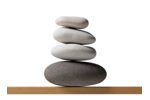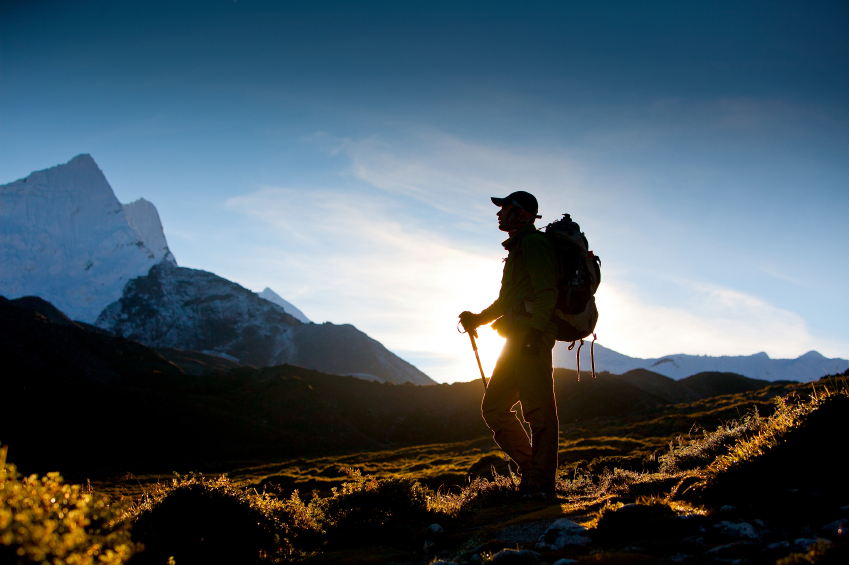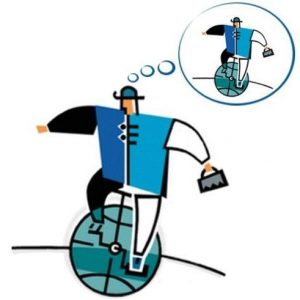Minding Your Balance

Class #4 & 5 - Winter Workshop 2019
Focus Cues for Better Balance

Visual Focus and Intention
Visual focus and intent to act lead movement. From a grounded posture extend visual focus and/or a felt sense of forward intention. To remain stable when you need to look down while walking, maintain a felt sense of moving forward.
To maintain stable posture when stepping backwards, extend visual focus forward; this helps keep the upper body over the hips, legs and feet.
Sense of Space
Our sense of space relies on the same multisensory input as our sense of balance: vestibular (inner ear sense of motion), visual, tactile, and proprioceptive (sensory info from muscles and joints). That’s why vertigo makes us unsteady on our feet and causes the room to spin. Tuning into spatial awareness enhances our perception of the same multisensory composite that underlies good balance, thereby helping us be more stable on our feet.
Sense of space operates quietly in the background of attention, providing the framework for knowing our whereabouts in relationship to the landscape. It underlies our perception of the way we’ve come and the direction we’re headed; of what’s to our right and left, overhead, underfoot, within reach and on the far horizon.
Intentionally tune in to your peripheral vision throughout the day in everyday environments that you normally take for granted, e.g., while walking around the house, strolling through the neighborhood, even sitting at your computer. Notice the general sense of your place in the environment that's informed by sight, sound, and the whole-body feel of you from front to back, side to side, and top to bottom. Remember - it’s not just about the external space; it’s about your orientation in that space - what’s near or far, in front or behind, left or right, above or below.
The more you practice, the more likely an awakened spatial awareness will become an automatic part of how you move through the world!

General Notes
Experiences from the Week(s)
- Weight Underside carrying heavy boxes of books
- Shoveling snow - positioning hips; working both sides of the body from the center line
- Weight underside opening jars!
- Weight underside to improve balance during yoga
- Extending focus walking through a crowded hall (and think about this in the mall)
- Skiing - putting it together: weight underside foundation; visual focus to destination; move from center
Weight Underside Meditation
- Lightly tense and release muscles beginning with the face and working down through the whole body
- Notice the effect tensing and releasing one area has on other parts of the body, including what happens to your breathing
The Mind/Body Connection - "Unbendable Arm"
- Combine intention and action by pointing
- Unbendable arm as an extension of centering the whole of me
- Bring awareness to feeling the position of the arm
Sense of Space/Peripheral Vision
- Take note of all you can see above, below and to the sides even when looking straight ahead
- Tuning in to peripheral awareness when walking allows you to keep good upright posture and still know what's on the ground in front of you
Mind Body Techniques for Better Balance
- Focus - extend awareness and intention where you want to go, both visually and with a felt or somatosensory awareness of moving forward.
- Up & Down - rise up and down on toes alighting with weight through the balls of your feet and toes rather than back on your heels.
- Sense of Space - Tune in awareness to the space around you; notice the general sense of your place in the environment that's informed by visual, auditory, and somatosensory information.
- Weight Underside - relax! Feel your weight drop with gravity
- Compare to be Aware - shift your weight from side to side (and/or front to back) to find the feel of balance between the two extremes. Do the same moving just your attention from side to side or front to back. Do you feel your body move?
- Center - place attention at your center of balance. Remember that center is a vantage point from which to act, not a place to lock attention.
Keep In Mind
Navigation
Perceiving and navigating space rely on the same brain regions that support memory and planning. According to researchers,* “the neural algorithms underlying navigation in real and mental space are fundamentally the same.” This relationship underlies the impact of "sense-of-space" as it goes beyond balance control to influence cognitive clarity.
*György Buzsáki & Edvard Moser
Practice & Application
Minding Movement
- Using the balance techniques in your favorite exercise and sports activities (e.g., yoga, singing, hiking, riding a bike) will help your performance in the activity and provide an opportunity for developing better balance skills for everyday life.
- Be aware of your postural stability when carrying objects. Are your arms and shoulders relaxed and Weight Underside? Has the weight of the object pulled you off balance? Has the focus of your attention on the object destabilized your balance?
- The Minding Your Balance™ concepts and tools are not unique to Ki-Aikido; many other practices address the same things in different ways. Notice how similar concepts are discussed or practiced in different activities.
"Ki" Phrases
- All of the tools (Center, Weight Underside, Focus, Spatial Awareness, etc.) can be quick mental cues for optimizing your equilibrium - physically, mentally and emotionally.
- Practice using the cues in non-challenging situations (e.g., pushing a shopping cart)
- Draw on the cues in challenging circumstances (e.g., slippery or uneven surfaces, poor lighting, crowded spaces, sports)

More Resources
Check out the Balance Blog for more stories about understanding and using the Minding Your Balance tools.